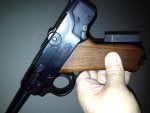Rimfire Newbie From Centerfire World With A New Stoeger
Hi All,
This is my first post here, and I hope it kinda fits. I've used and reloaded for a dizzying array of centerfires but never understood the appeal of a rimfire until a week ago when I was exploring a small town pawn shop and saw an almost pristine Stoeger Luger. I bought it for $249.99 with no box or papers and only a single magazine. Got another can of Ballistol and cleaned 'er up, and set out with a 350-pack of Federal Auto Match for the range.
Whooee, what a blast! No misfires at all, just one happy mag after another and does this thing ever shoot tight! I'm in love for sure now. So, here I am, a new and willing recruit to the rimfire world. I did read a fair amount of posts to the effect that these 22s are not real Lugers, and then there were some coming back with the fact that Stoeger owns the rights to the name and so anything they build and call a Luger is, by definition, a real Luger,
Here's my take. The prototype for our American idea of the Luger is the P '08 we encountered in war and that was originally marketed here by Stoeger as a "Luger" between the wars. It's action works very simply like this: three pins, at the breech face, the toggle, and the rear of the bolt are located in relative alignment with the recoil thrust vector, a line we can draw through the barrel axis, the bolt, and out the rear of the receiver. The forward and rearward pins are directly in line with the thrust vector and the toggle is ever so slightly below the thrust line. The barrel and bolt are latched together and slide back in recoil on the receiver floor, then they part when the toggle pin is cammed upward. The breechblack continues backward extracting the case, cocking the striker, and returning to strip and chamber a new round as the barrel and bolt reacquire each other in battery.
Stoeger says in its manual that the 22 Luger is an improved toggle action, so let's examine that claim. Again, the thrust vector passes through the barrel axis, through the bolt, and out the rear of the receiver. This time the toggle pin is ever so slightly above the thrust vector while the other pins are directly aligned with it. Upon firing, the case pushes on the breechblock but the breechblock only returns the recoil thrust times the cosine of the angle of incidence on the center of the toggle pin. That slight surplus of recoil energy at the case accelerates the breechblock and engages the recoil spring (called the drive spring by Stoeger), and the mainspring as the hammer is cocked. The sin of the angle of incidence of recoil energy acts upwards vertically to drive the toggle up and allow the bolt to move backwards. So the Stoeger has eliminated the locked barrel/breech, and replaced the striker with a simple hammer while containing the 22 LR pressure with a lower parts count.
The stamped toggle parts act as an effective dust cover for the bolt, hammer, and springs. By the way, the Stoeger in its early form (made from 1969 through 1979, the early form had a forged aircraft-grade T-6 aluminum frame with a steel barreled action of mid-carbon 1050 steel) sat its toggle action atop and within a "tub" or "chassis" of steel so no aluminum/steel interaction could occur. To my knowledge that is the first use of this modern "chassis" concept that is now so successful in all our polymer guns. So, by my analysis and my emprirical observations the Stoeger Luger is operationally a real Luger, and is manifestly a gem of engineering reasoning and manufacturing excellence.
Now, having said all that, it's also plain that the Colt Woodsman, and Ruger Mk I and many others also "improved" the toggle action (improving it away altogether) with an even lower parts count, and this solution must have been apparent also to the Stoeger engineers at the time. Evidently, the thinking must have been that the allure of the Luger was simply too powerful to pass up the opportunity---both for the ultimate buyers and for the builders themselves. That mystique certainly worked on me, as it was love at first sight, which I'm happy to report still thrives.after the tasting :2ar15smil










